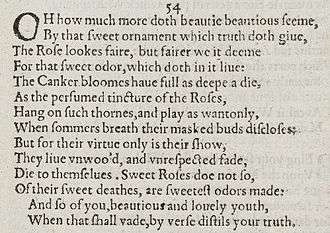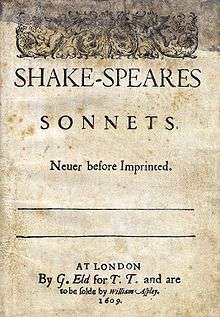Sonnet 54
| Sonnet 54 | |||||||
|---|---|---|---|---|---|---|---|
 Sonnet 54 in the 1609 Quarto | |||||||
|
| |||||||
| |||||||
Sonnet 54 is one of 154 sonnets written by the English playwright and poet William Shakespeare. It is a member of the Fair Youth sequence. These sonnets are written from the perspective of an older man displaying his fondness of a younger man. It uses an extended metaphor to develop the theme of the beauty of the beloved and the preservative power of verse.
Introduction
The sonnets were first published together in 1609, although evidence points to Shakespeare finishing them at least 12 years earlier.[2] A. Kent Hieatt, Charles W. Hieatt, and Anne Lake Prescott published an article in Vol. 88 of Studies in Philology detailing a computer assisted study which partially confirmed this conjecture. It determined that Sonnets 1-60 were first composed sometime in between 1590 and 1595, but then likely revised after the turn of the century. In order to determine this, they looked at how Shakespeare's use of words changed over time and what current events and works he references.[3]
Structure
Sonnet 54 is an English or Shakespearean sonnet. The English sonnet contains three quatrains followed by a final rhyming couplet. This poem follows the typical rhyme scheme of the English sonnet, abab cdcd efef gg and is composed in iambic pentameter, a type of poetic metre based on five pairs of metrically weak/strong syllabic positions per line. The fifth line exemplifies a regular iambic pentameter:
× / × / × / × / × / The canker blooms have full as deep a dye / × × / × / × / × /(×) As the perfumed tincture of the roses, (54.5-6)
- / = ictus, a metrically strong syllabic position. × = nonictus. (×) = extrametrical syllable.
The sixth line exhibits a possible initial reveral (though it may also be scanned regularly), and a final extrametrical syllable or feminine ending. As the rhyme scheme demands, the eighth line matches the sixth's feminine ending.
Synopsis
Sonnet 54 by William Shakespeare is divided into three quatrains and one heroic couplet. The first two couplets work together, illustrating both the scentless canker bloom [4] and the scented rose. In the first two lines of the first quatrain he says that beauty is more precious as a result of truth. In the next two he gives the example of a rose. He says that beyond its looks, we prize the rose for its scent. This scent is its "truth" or essence. In the second quatrain Shakespeare compares the rose to the canker bloom. They are similar in every way other than scent. Shakespeare use of the words "play" and "wantonly" together imply that "play" has a sexual connotation.[5] In the third quatrain the author compares the death of the two flowers. The canker bloom dies alone and "unrespected", while roses do not die alone, for "of their sweet deaths are sweetest odours made". In the final section, the heroic couplet, Shakespeare makes the point of the sonnet clear. He says that his poetry will distill the beautiful boy's beauty, his truth, even after it fades. It is interesting to compare this distillation to sonnet 5, where marriage was the distiller and beauty was distilled.[6] In either sonnet one gets the same result of the distillation process, which is beauty. However, in sonnet 5 the distillation process was through marriage, and in sonnet 54 it is the narrator's verse that distills this beauty. This the final product of the distillation process is brought to one in the final couplet of the poem, thus making the poem like the distillation process. This leaves the product of the verse, which is truth, enforcing the narrator's promise to leave only truth through his verse.
Roses
This poem is a comparison between two flowers that are representations of the youth's beauty. Shakespeare compares these flowers, which vary greatly in their appearance, although they are essentially the same kind of flower, it is obvious that the "canker-blooms" or wild roses, according to Katherine Duncan-Jones, are the less desirable then that of the, assumed, damask or crimson rose.[7] Since the wild roses do not prolong their beauty after death, they are not like the youth–who even after death shall be immortalized in the writers words of the sonnet.
Duncan Jones adds: "There is an additional problem about Shakespeare's contrast between 'The rose' and 'The canker blooms'. It is strongly implied that the latter have no scent, and cannot be distilled into rose-water: for their virtue only is their show. 'They live unwooed, and unrespected fade, Die to them selves. Sweet roses do not so ...' Yet it is clear that some wild roses, especially the sweet briar or eglantine, had a sweet, though not powerful, fragrance, and could be culled for distillation and conservation when better, red, roses were not available: their 'virtues' were identical".[8]
Literary influences
Shakespeare's sonnets are an important development in the historical progression of English poetry. The era in which Shakespeare was writing his sonnets was one of divergent literary values. He defied his society's contemporary tastes, along with "Sidney and Spenser, the other two most prominent sonneteers" of the sixteenth century, by embracing the sonnet form, which had largely gone out of fashion. Nonetheless, he filled his sonnets with references to other Elizabethan poets whom he respected. In Sonnet 54, especially the line "The rose looks fair, but fairer we it deem,” we see a reference to Edmund Spenser's Amoretti, Sonnet 26, the first line of which is "Sweet is the rose, but growes upon a brere." This reference is just one of many which help to "proclaim Shakespeare's deepest literary values and his recurrent aesthetic convictions."[9] While Shakespeare honors his contemporaries, one of the things that make Shakespeare so great was how he differed from them. The Amoretti is a series of sonnets focused on a much more traditional topic, the courting which led to Spencer's marriage. In the Amoretti, Spenser proposes "that a resolution to the sonneteer's conventional preoccupations with love may be found within the bounds of Christian marriage."[10] Shakespeare's Sonnets have a much more complicated, pained, and almost indecipherable message about love.
Context in sonnet sequence
The context of the sonnets vary, but the first 126, amongst which sonnet 54 is found, are addressed to a young man of good social status and profess the narrator's platonic love. The love is returned, and the young man seems to yearn for the sonnets, as seen in sonnets 100-103 where the narrator apologizes for the long silence.[11] However, Berryman suggests that it is impossible to determine how the relationship ended up. While theories exist that the sonnets were written as literary exercises, H. C. Beeching suggests that they were written for a patron and not originally intended to be published together.[12]
Sexuality
In an analysis of Margreta de Grazia's essay about Shakespeare's sonnets, Robert Matz, mentions the subject of Shakespeare's sonnets (such as Sonnet 54) being written to a man. Drawing on a Foucauldian history of sexuality, De Grazia and Matz argue that while this notion appears scandalous in modernity, in Shakespeare's time this was not the same kind of issue. Sonnets written to a woman could have been considered more improper in Shakespeare's era because of the possible class difference and the idea of a woman's presumed promiscuity (originating in the idea of Eve causing the fall of man by enticing Adam to eat the forbidden fruit). According to Matz, "contemporary categories of or judgments about sexual desire may not cohere with past ones. De Grazia usefully argues that the changing reception of the sonnets marks a shift from an early modern concern with sex as a social category to modern understanding of sex as a personal one".[13] The notion of homosexuality versus heterosexuality is a modern development that simply did not exist in 16th century England. Readers may have disapproved of Shakespeare's same-sex love or male friendship before the mid-20th century but they would not have reacted to the text as Shakespeare presenting himself as a "homosexual". Rather they would have pointed to other sonnets to prove his heterosexuality, and therefore find consolation in that.[14]
Notes
- ↑ Pooler, C[harles] Knox, ed. (1918). The Works of Shakespeare: Sonnets. The Arden Shakespeare [1st series]. London: Methuen & Company. OCLC 4770201.
- ↑ The Sonnets of Shakespeare, edited by H. C. Beeching, p. 225 GoogleBooks
- ↑ Schiffer, James. Shakespeare's Sonnets. New York and London: Garland Publishing, Inc., 1999
- ↑ Shakespeare's Sonnets, edited by Stephen Booth (Google Books)
- ↑ Shakespeare's Sonnets, edited by Stephen Booth (Google Books)
- ↑ Beeching 96
- ↑ Katherine Duncan-Jones. Deep-dyed canker blooms: botanical reference in Shakespeare's Sonnet", The Review of English Studies 46.n184 (Nov 1995): pp521(5).54.
- ↑ Katherine Duncan-Jones. "Deep-dyed canker blooms: botanical reference in Shakespeare's Sonnet", The Review of English Studies 46.n184 (Nov 1995): pp521(5).54.
- ↑ William J. Kennedy, "Shakespeare and the Development of English Poetry", The Cambridge Companion to Shakespeare's Poetry, ed. Patrick Cheney. Cambridge: Cambridge University Press, 2007
- ↑ Larsen, Kenneth J. Introduction. Edmund Spenser's Amoretti and Epithalamion: A Critical Edition. Tempe, AZ: Medieval & Renaissance Texts & Studies, 1997.
- ↑ Berryman, John. Berryman's Shakespeare. New York: Farrar, Straus, and Giroux, 1999. 287
- ↑ The Sonnets of Shakespeare, edited by H. C. Beeching GoogleBooks
- ↑ "The Scandals of Shakespeare's Sonnets", Robert Matz, ELH 77.2 http://muse.jhu.edu/journals/elh/v077/77.2.matz.pdf
- ↑ "The Scandals of Shakespeare's Sonnets", Robert Matz, ELH 77.2 http://muse.jhu.edu/journals/elh/v077/77.2.matz.pdf
References
- Matz, Robert. "The Scandals of Shakespeare's Sonnets", .
- Duncan-Jones, Katherine. "Deep-dyed canker blooms: botanical reference in Shakespeare's Sonnet", The Review of English Studies 46.n184 (Nov 1995): pp521(5).54.
- The Sonnets of Shakespeare, edited by H. C. Beeching Google Books
- Berryman, John. Berryman's Shakespeare. New York: Farrar, Straus, and Giroux, 1999.
- Schiffer, James. Shakespeare's Sonnets. New York and London: Garland Publishing, Inc., 1999
- Kennedy, William J. "Shakespeare and the Development of English Poetry", The Cambridge Companion to Shakespeare's Poetry, ed. Patrick Cheney. Cambridge: Cambridge University Press, 2007.
- Larsen, Kenneth J. Introduction. Edmund Spenser's Amoretti and Epithalamion: A Critical Edition. Tempe, AZ: Medieval & Renaissance Texts & Studies, 1997.
- First edition and facsimile
- Shakespeare, William (1609). Shake-speares Sonnets: Never Before Imprinted. London: Thomas Thorpe.
- Lee, Sidney, ed. (1905). Shakespeares Sonnets: Being a reproduction in facsimile of the first edition. Oxford: Clarendon Press. OCLC 458829162.
- Variorum editions
- Alden, Raymond Macdonald, ed. (1916). The Sonnets of Shakespeare. Boston: Houghton Mifflin Company. OCLC 234756.
- Rollins, Hyder Edward, ed. (1944). A New Variorum Edition of Shakespeare: The Sonnets [2 Volumes]. Philadelphia: J. B. Lippincott & Co. OCLC 6028485.
- Modern critical editions
- Atkins, Carl D., ed. (2007). Shakespeare's Sonnets: With Three Hundred Years of Commentary. Madison: Fairleigh Dickinson University Press. ISBN 978-0-8386-4163-7. OCLC 86090499.
- Booth, Stephen, ed. (2000) [1st ed. 1977]. Shakespeare's Sonnets (Rev. ed.). New Haven: Yale Nota Bene. ISBN 0-300-01959-9. OCLC 2968040.
- Burrow, Colin, ed. (2002). The Complete Sonnets and Poems. The Oxford Shakespeare. Oxford: Oxford University Press. ISBN 978-0192819338. OCLC 48532938.
- Duncan-Jones, Katherine, ed. (2010) [1st ed. 1997]. Shakespeare's Sonnets. The Arden Shakespeare, Third Series (Rev. ed.). London: Bloomsbury. ISBN 978-1-4080-1797-5. OCLC 755065951.
- Evans, G. Blakemore, ed. (1996). The Sonnets. The New Cambridge Shakespeare. Cambridge: Cambridge University Press. ISBN 978-0521294034. OCLC 32272082.
- Kerrigan, John, ed. (1995) [1st ed. 1986]. The Sonnets ; and, A Lover's Complaint. New Penguin Shakespeare (Rev. ed.). Penguin Books. ISBN 0-14-070732-8. OCLC 15018446.
- Mowat, Barbara A.; Werstine, Paul, eds. (2006). Shakespeare's Sonnets & Poems. Folger Shakespeare Library. New York: Washington Square Press. ISBN 978-0743273282. OCLC 64594469.
- Orgel, Stephen, ed. (2001). The Sonnets. The Pelican Shakespeare (Rev. ed.). New York: Penguin Books. ISBN 978-0140714531. OCLC 46683809.
- Vendler, Helen, ed. (1997). The Art of Shakespeare's Sonnets. Cambridge, MA: The Belknap Press of Harvard University Press. ISBN 0-674-63712-7. OCLC 36806589.
.png)
